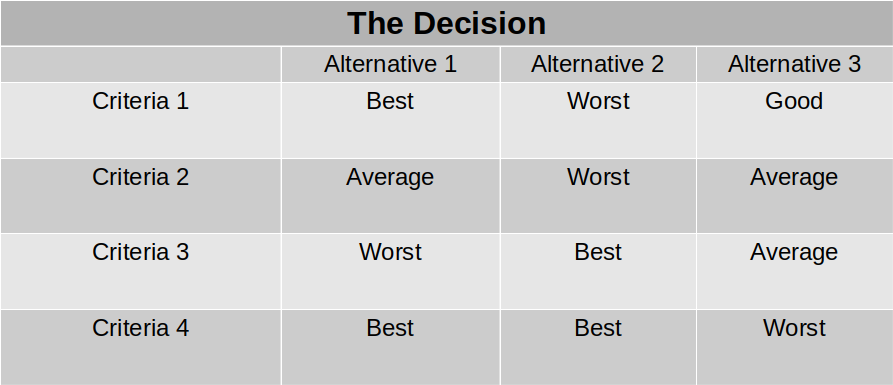Decision-making is selecting or making a choice among a number of possible options.
What are the basic components of a decision?
1. The Decision – a question or issue demanding an answer
2. A set of Criteria – ways of evaluating alternatives
3. The Alternatives – possible answers to the question/issue
Making the Decision is selecting an Alternative(s) based on its response to the Criteria.

Decisions spans the levels from relatively insignificant (what to have for breakfast) to the critical (the allowable over-pressure in a nuclear plant cooling system considering environmental condition and age of equipment). And while the range of impact (individual success in a foot race vs. regional devastation) varies, the basics remain the same.
The basic process is:
1. State the Decision to be made
2. Develop Criteria to compare the alternatives
3. Develop a set of Alternatives (possible solutions)
4. Evaluate the Alternative with the Criteria
5. Evaluate the risks (and/or opportunities) of the ranking Alternative(s)
6. Select Alternative(s) based on the data
The process is straight-forward. It is a repeatable method that can be applied across the range of decision types. It is scalable in that the effort applied to developing criteria and alternatives can be adjusted as can the depth of evaluation. If there is cereal in the cabinet and milk in the refrigerator and little else, the breakfast decision is simple. Given time and ingredients, the decision could be harder.
This process can be executed ‘in your head’, on paper, with a spreadsheet (look under ‘Tools’) or with a dedicated tool, depending on the difficulty of the decision, or the number of data gatherers or decision makers involved, or the need to document the process/result..
If information about the decision and process is captured, the decision can be revisited and both the specific decision and the general process execution can be improved.
So while we suggest an awareness that decisions are being made, we do not suggest that every decision needs a fully elaborated decision capture. The ability to determine when more thoroughness is required however, is a relevant skill.
![]()